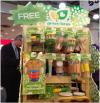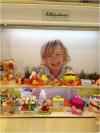Toy Market Trends: Wi8 Panel Looks at Buying, Pricing, Merchandising & More
The “Toy Market Trends” session at Winter Institute 8 featured panelists Suzanna Hermans of Oblong Books & Music in Rhinebeck, New York; Jonny Girson of The Learning Tree in Kansas City, Kansas; and Carle Wunderlich of Best Toys in Lisle, Illinois. Hermans’ general bookstore does 25 percent of its sales in children’s books and eight percent in toys. Girson is a local, independent toy retailer who has been in business for 17 years and does 15 percent of his sales in books, and Wunderlich has been in the toy business since 1980 and now works both as a sales representative and distributor of toys across the U.S.
The February 25 afternoon panel began with a discussion of how toy buying, pricing, merchandizing, and marketing differ from norms in the children’s book industry.
Toy buying is “very individual,” Girson said, and Hermans agreed that she often relies on instinct or gut feeling when buying toys. Girson recommended looking closely at how a toy will be packaged before buying. “It’s such a big deal,” he said, and has strong influence on a product’s appeal.
When planning to bring in a new toy line, it’s important to think about your existing stock, so you avoid competing with yourself, the panelists agreed. Wunderlich encouraged booksellers to “first decide on a category” that they’d like to expand and noted that “there are some categories that do better in bookstores than others.” Among the top sellers, he said, are games, puzzles, and arts and crafts items.
Booksellers who are interested in adding or expanding their toy offerings were directed to check out awards lists for ideas. Among those mentioned were the American Specialty Toy Retailing Association (ASTRA) Best Toys for Kids, Mensa Select, and The National Parenting Center Seal of Approval. “The ASTRA awards are voted on by retailers,” Girson said, making them especially relevant. The ASTRA and Toy Fair shows were cited as valuable places for both product discovery and purchasing specials.
Regarding the pricing of toys, Girson said that retailers have moved away from keystone pricing, which was “basically doubling your cost to get the retail price.” Instead, he said, “retailers have moved toward value pricing.… You sell something for what it is worth, not what it costs.” Worth is determined by the retailer on a case-by-case basis.
Hermans reminded booksellers that “for the majority of toy companies, freight is not free,” so she factors the cost of shipping and handling into her retail cost. “Make sure to ask where the items are shipping from,” she cautioned, “so you don’t get a big surprise … be savvy on that point.” Wunderlich added, “I find our stores add a dollar to almost everything” to cover the freight charges.
As far as merchandizing and marketing go, Girson suggested setting out a display copy of most toys. “We probably open 70 percent of our product,” he said. Opening product allows both staff and customers to become familiar with new toys, and Girson has seen nothing but positive results. He also highlights a “toy of the week” on his website and said that “game nights are generally good” at getting the word out about new products.
Hermans noted that booksellers can promote toys in their store newsletters and said that she even hopes to use her store’s Twitter account to tweet about them in the future.
Each of the panelists then shared some of their favorites for 2013. Wunderlich highlighted some Toy Fair finds, including a new Hohner Inc. line of eco-friendly children’s instruments called Green Tones (available in May). “The quality of sound on these instruments is quite incredible,” he said.
Wunderlich and Girson both said that HABA Lilliputiens® — high-end soft toys with a wholesale cost from $6.50 to upwards of $30 — were going to be big this year. “The product is absolutely fantastic,” Girson noted.
Girson also touted Magformers® and Magna-Tiles® as “great lines” for customers interested in “open-ended building.” In fact, Learning Tree’s number-one selling item is the $120 Magna-Tiles set, he said.
Hermans mentioned that Hogwild® Poppers have done very well at Oblong. “It’s a fun item,” she said, “and they have to buy two, right? Because kids want to play with each other!” Hermans also lauded the Pocket Disc™. To highlight the product, she brought a video display into her store and reported that “it has become [Oblong’s] number-one selling item.”
As the panel came to a close, the discussion returned to the importance of using sales reps to find toys that will work best for independent retailers in 2013. “Your rep should know how much involvement the company has with the big box stores … and should be able to guide you,” Wunderlich said. If a big box store does begin carrying a product that was once “special to indies,” Hermans does not lose hope. “That’s why you change what you carry,” she said. Indies are designed to be adaptable.



